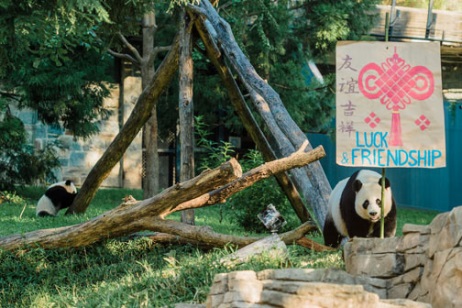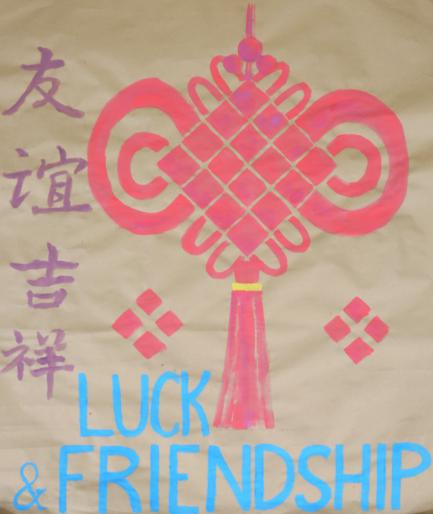Smithsonian’s National Zoo Celebrates Giant Panda Bei Bei’s First Birthday
Bei Bei's developmental milestones
The National Zoo and the Embassy of the People’s Republic of China celebrated giant panda cub Bei Bei’s (BAY-BAY) first birthday this morning with a Zhuazhou (dra-JO) ceremony. During a traditional Zhuazhou ceremony, symbolic objects are placed in front of a baby. The item that the baby reaches for first foretells something about his or her future. The Zhuazhou for Bei Bei was slightly modified for a panda cub. Three posters with symbols painted on them were placed in Bei Bei’s yard. Each poster had a different image painted by the children of the Chinese embassy’s families.
Ambassador Cui Tiankai; Dennis Kelly, director of the National Zoo; and David Rubenstein, Smithsonian Regent and philanthropist, placed the banners in the panda yard. One banner had peaches painted on it; in China, peaches are a symbol of longevity. The second banner had bamboo painted on it, representing good health and habitat for the panda cub. The final banner had a traditional Chinese red ‘knot’ symbolizing friendship and luck. Mother Mei Xiang (may-SHONG) chose the red knot on behalf of Bei Bei, which means he will serve as an ambassador for scientific collaboration. Scientists at the Smithsonian’s National Zoo and Conservation Biology Institute and scientists at the China Research and Conservation Center for the Giant Panda in Wolong, Sichuan Province, have been working together to learn about giant pandas and save them since the 1970s.
“To giant panda fans around the world, Bei Bei is our charismatic cub who has charmed visitors with his bold personality, laid-back temperament and playful behavior,” Kelly said. “To our dedicated team of animal care staff and scientists, this bear represents more than four decades of conservation research and excellence in giant panda husbandry. Today, we celebrate that we have been able to share our panda story—from the science behind his conception to his first steps and beyond—and we look forward to what he will teach us in the future.”
At 1 p.m., Bei Bei (turning 1 Aug. 22) and Mei Xiang, Bao Bao (BOW-BOW) (turning 3 Aug. 23) and Tian Tian (tee-YEN tee-YEN) (turning 19 Aug. 27) will receive tiered birthday cakes made by the Zoo’s nutrition department. The tiers are made of frozen diluted juice and were dyed various colors using beet juice, carrot juice, apple juice and food dye. The cakes were decorated with flower appliques carved from apples, pears, cooked sweet potatoes, leaf-eater biscuits and arrow bamboo—some of the pandas’ favorite foods. In lieu of icing, a large number “1” carved from frozen diluted apple juice sat atop Bei Bei’s cake; keepers also topped the cake with some honey for a special treat. Guests and panda fans are encouraged to tweet their birthday wishes for Bei Bei today and support panda conservation using #PandaStory.
Guests enjoyed Dan Dan (dahn-dahn) noodles courtesy of the Chinese embassy. The cold noodles are a dish from Sichuan Province. The China Conservation and Research Center for the Giant Panda in Wolong in Sichuan Province is where Mei Xiang and Tian Tian were born and where Bao Bao and Bei Bei will live when they move to China. Guests will also receive a commemorative postcard for Bei Bei’s first birthday on a first-come, first-served basis. The postcard includes calligraphy of Bei Bei’s name in Chinese painted by 16-year-old Yingzhe Liu.
Bei Bei’s birth one year ago was a significant conservation success for the National Zoo and Conservation Biology Institute, which has been studying giant pandas for 44 years. He was born as the result of a precisely timed artificial insemination performed by the panda team at the Zoo, which included Zoo scientists, veterinarians and keepers, and scientists from the China Conservation and Research Center for the Giant Panda. Around the age of 4, Bei Bei will travel to China and enter the breeding program for giant pandas.
# # #
SI-410-2016


